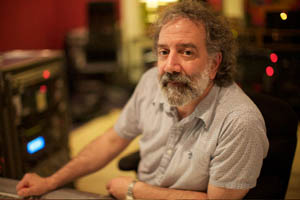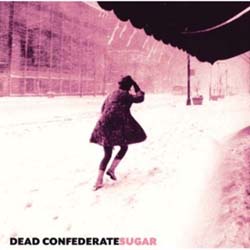John Agnello: Dinosaur Jr. & Sonic Youth Producer On New Indie Rock Sounds, Classic Techniques
JERSEY CITY: In 1979, a Brooklyn teenager and avid record collector named John Agnello landed an internship at one of Manhattan’s most prominent music studios. Thanks to some hard work and genuine affability it wasn’t long before he found himself assisting on major releases from contemporary heavyweights like Aerosmith, Cyndi Lauper and Twisted Sister.
It’s an unexpected beginning for a Producer most known for his involvement with classic Indie Rock darlings, many of whose records still pepper the favorites lists of young fans. Success on early releases with Dinosaur Jr, Screaming Trees and Buffalo Tom made way for work with The Breeders, Sonic Youth, The Hold Steady and Nada Surf.
We grabbed a quick bite with John near his Jersey City home between sessions with Kurt Vile at Williamsburg’s Headgear Recording Studio.
Looking through your early discography, we see you listed as an assistant on some pretty mainstream releases. It’s interesting to see your credit list take a left turn in the early 90s toward more bold and unique artists, branded back then as “Alternative Rock.” It looks like you’ve never turned back. I’d like you to take us through that journey a little. How did you get your start?
I started assisting at the Record Plant in ’82, and started engineering in ’84. I was engineering for a long time, all through the 80s and into the early 90s. It took a while to really get considered to produce records. And with good reason! (laughs) I wasn’t really a “Producer” at first.
What changed? Were there any seminal records that acted as a turning point for you?
The first Dinosaur Jr. record was a really great experience. I was credited as an engineer, and I wouldn’t say I was a “producer” on those records. But I definitely helped J. [Mascis] get to a different sonic level. When we worked on together, Dinosaur Jr. records started to sound like classic records, not just gnarly discs with great songs covered in “Ka-Kssshhhhh” (makes sound effect of gnarly midrangey goodness). Once those records were doing really well and A&R guys noticed what I was starting to contribute to the process, things began to change.
How does your approach as a producer differ from that of your engineering days? Is there a learning curve?
Over the years I’ve learned a lot about what a producer can do, and pushed the envelope a lot more. When I started producing, it was in the middle of this Indie/Alternative Rock explosion. Things were really open. What a producer had to do was create a vibe, get the bands to perform, and let them do their thing. You might help with an arrangement here or there, but that was it. Bands were being signed because somebody somewhere liked them.
The attitude was: if a band like Spacehog or Nada Surf or Jawbox hit the charts, great! And if they didn’t… they didn’t. In that way it was a totally different world.
Today, I spend a lot more time in rehearsals with bands really working through arrangements and giving them actual direction. Things these days are so much tighter. There are so many records coming out, indie-wise at least, and it’s so much more competitive because everyone posts their songs online.
For an unknown band to have a chance of getting noticed, it’s really important for the record to be concise and bring out the best of what they do. Sometimes we’ve got to leave out all the extra filler that makes listeners go: “Boring!” Attention spans have gotten to be…miniature.
So do you find yourself working more as a musical gatekeeper than you would have in the past?
Absolutely. I’m in pre-production rehearsal with bands right now, and you have to bring these things up: “The song’s too long, let’s cut the chorus here in half here,” or “The key’s not right for your voice, let’s try modulating there.” When you’re making good suggestions, bands are really receptive. And it’s fun too. You feel like you’re even more a part of the band and a part of the record. It’s great to notice: “Hey the verse… It’s really this song’s chorus, isn’t it? Let’s build around that.”
Let’s face it: anyone can be an engineer these days. That’s no slight against the guys who are great engineers, because there are some really good ones. The point is: Any one of these bands *could* stay at home and make their own record. These days just being an engineer isn’t enough to separate yourself from everyone else out there. You’ve got to bring something else to the table.
So here you are being hired for your ability to filter and to make perceptive musical choices… but you didn’t even start out as a musician?
No, not at all!
How did that happen? Did you become a player as things wet along?
I didn’t. That’s another thing that’s interesting to think about: when I first started assisting, I really had no concept of pitch. I was just a kid who loved listening to records. I wasn’t a musician, I wasn’t trained. I had to learn to listen and understand what pitch was and to focus on it. It’s just another one of those things that you learn to do well through repetition.
You’ve done a lot of work with promising bands as they’re discovering their sound. But you’ve worked with established artists as well. The last two Sonic Youth records you’ve worked on have featured some really masterful sounds.
Considering how long they’ve been around and how long I’ve been around, it’s been really great to finally work with them. It made me feel really good about my station in life, to be able to make two really wonderful records with a band I’ve always loved.
Sonic Youth are a band known to have a lot of vision and often share production credit on their records. How is your role different with a band like that?
Oh, they know what they’re doing. A big difference between working with a Thurston Moore or a J Mascis and all the other bands we’re talking about, is that you don’t need to tell either of those guys anything about songwriting (laughs). What’s the point?! What a band like Sonic Youth really requires is that we’re on time delivering the record, and I can help keep them on track while they have so many other projects going on.
Rather Ripped in particular made some waves for helping put the band back on the map after some rare time away from critical acclaim. That album took a distinctly punchy and muscular sonic direction compared of their prior records. The guitars in particular command an unusual amount of power and clarity. Can you tell us anything about your approach there?
Rather Ripped (2006) and The Eternal (2009) both have Lee on the left and Thurston on the right. That’s how they stand on stage. I just love the clarity of stereo. It’s great to hear each dude doing their part, and it’s really cool to hear that in headphones, especially when one part steps out a bit from either side.
Definitely. It leaves a lot of room for power in the drums too. I hear that kind of spread on one of your newest releases as well. Dead Confederate’s Sugar came out this past month, and in some places the guitars are also really wide, but much more textured and layered sounding.
They have a cool sound. I joke that’s almost like “Freedom Grunge.” You know? Like Freedom Rock + Grunge, with some shoegaze mixed in. It combines a lot of things I like.
I’ve heard you tend to use the same mics a lot on guitars: a classic combination of [Shure] SM57, [Neumann] U87 and [Sennheiser] 421 mixed together. Is that true of those two records, even though they have such different sounds?
Yeah, a lot of it comes from the amp, and the player. That’s the first place to change things. If there’s something that ties those sounds together it’s that I really like my guitars close-miked, even if they have a lot of effects on them. If your amp is really blowing and you have the mic right on it, that’s where you get a lot of intensity. If you start to move it back, sure you can get some more air and some room maybe, but you sacrifice that intensity.
When you use a blend of mics like that, which mics are you listening to in the control? What about the players?
I’m old school. I’ll blend them together and print it to tape or to Pro Tools. If I’ve got a great sound that’s moving me, I don’t want to have to think about how I got it ever again. When I’m producing, I want to shut up the Engineer-guy in my head as much as possible so the Producer-guy can take the wheel. Sometimes I’ll even print my snare top and bottom on one track.
What about kick drums? Some of your records have a powerful-yet-organic sound you don’t hear a lot these days.
I think both those Sonic Youth records and a lot of the Dino stuff is a double-headed kick drum, no hole. It’s really hit-or-miss though. If you put a mic up on either side and it sounds good, you’ll have an amazing sound. If it doesn’t, you could struggle with mics and anything else for hours and you’ll never get there.
What else are you excited about? I hear you’re in the studio with Kurt Vile now, making a record for Matador.
He’s great. Really quirky, unique stuff while also being classic and beautiful. My daughter Bella is in love with him and sings his songs in the car all the time!
Have the digital and home studio revolutions changed the way you work much?

Agnello often works out of Headgear in Williamsburg, Magic Shop in Manhattan or Water Music in Hoboken. Photo by Andrew Kesin.
Not a lot in my niche. Every once in a while I’ll get a record to mix that was recorded by a new band at home. You wouldn’t get projects like that years ago. And sure, I use Pro Tools and edit digitally, but other than that, I pretty much work the same way.
I feel like you can’t make the same record all the time, and each album should be unique, but I use the same tools a lot. I pick my favorite studios like Water Music, Headgear and Magic Shop because they have tape machines that work and the monitoring is great. It’s almost embarrassing to admit, but I’ve been using the same stereo bus compressor for almost 24 years! (Laughs.)
— Justin Colletti
For more on John Agnello, visit his website at http://www.johnagnello.com and follow him on Twitter @John_Agnello.
Justin Colletti is a Brooklyn-based audio engineer and music producer who’s worked with Hotels, DeLeon, Soundpool, Team Genius and Monocle, as well as clients such as Nintendo, JDub and Blue Note Records.









